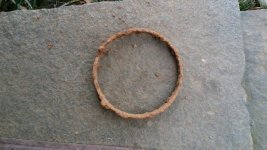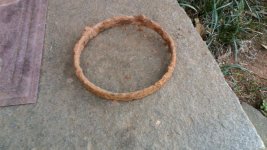This has been my experience with the Ace 400, as well. If it’s bouncing up to full-scale (99 on the Ace) from the mid 80s, it’s most likely large iron or similar. Like TriadH, I’ve never dug anything that hit 99 that turned out to be anything good except once - in that case, it was a rock solid 99, with absolutely no variation. Turned out to be a lead mold for a horse-mounted tin soldier toy. It registered as a 2” deep target, but ended up being 4 or 5 inches down.
You mentioned that the signal is showing about 12 inches square - is that in pinpoint mode? If so, it’s unusual for it to be showing 6” inches down
and that large of a surface area. Large targets should register as shallower than they actually are, because the detector interprets depth based on the assumption that the target is coin sized (see page 7 of the Ace 400 manual - but it’s true for all detectors). The size you’re describing may indicate a very large object that’s quite deep. If you aren’t in pinpoint mode, you may notice a few differences once you try it. First, you may be able to pine down the size to something smaller than 12” square. Second, depth registers more accurately in pinpoint mode, and you may find that the item displays shallower than 6”.
All that said, it might be something awesome - you can’t know for sure until you dig it out

I feel your pain on the headphones - I have a pretty small head (matches my very small brain

), so the stock headphones that come with the Ace 400 are a little too big for me unless I’m wearing a hat. It’s a problem I have beyond detecting - it’s a struggle for me to find aviation headsets for my job that fit well, also. Child sized units might be an option, but child sized headsets are usually lower quality. Let me know if you find a solution there, I’d be interested, too!






 ), so the stock headphones that come with the Ace 400 are a little too big for me unless I’m wearing a hat. It’s a problem I have beyond detecting - it’s a struggle for me to find aviation headsets for my job that fit well, also. Child sized units might be an option, but child sized headsets are usually lower quality. Let me know if you find a solution there, I’d be interested, too!
), so the stock headphones that come with the Ace 400 are a little too big for me unless I’m wearing a hat. It’s a problem I have beyond detecting - it’s a struggle for me to find aviation headsets for my job that fit well, also. Child sized units might be an option, but child sized headsets are usually lower quality. Let me know if you find a solution there, I’d be interested, too!





